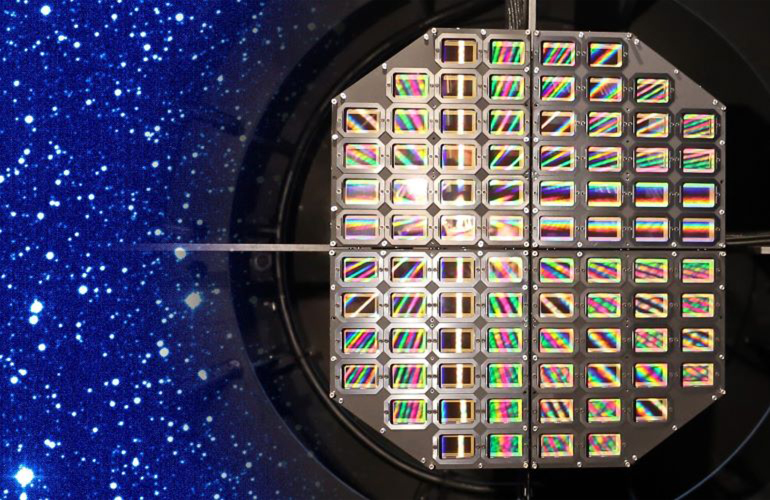What are technologies that capture purposeful images and videos?
Technologies that capture purposeful images and videos refer to the technologies which form the basis of Canon’s imaging field that capture not only light visible to our eyes but also a wide range of wavelengths we cannot see, such as electron beams, X-rays, near-infrared light, terahertz waves, ultrasound, and radio waves. Canon’s products use many different wavelengths. For example, CT systems use X-rays; cameras, printers, and office multifunction devices use visible light; ultrasonic diagnostic devices use ultrasound; and MRI systems use radio waves. All these products make use of the properties of specific waves to capture them true to their purpose.
Beginning with the camera sensor and optical technologies developed from our founding vision of creating the world’s best camera, Canon has accumulated many capture technologies, ranging from the microscopic world to the macroscopic. Our capture technologies are also well regarded for their low noise performance, which has led to more collaborations with other companies.

Advantages of Canon’s technologies that capture purposeful images and videos
The main advantage of Canon’s capture technologies is their extremely low noise, which allows the capture of images and videos true to their purpose. We capture many different wavelengths of light with our proprietary sensor technologies; transfer this light accurately and quickly with our stockpile of optical technologies as a camera maker and our proprietary precision mechanical technologies that achieve shape and drive precision at nanometer levels; and transform this light clearly to digital formats with our image processing technologies. By integrating these high-level technologies, we can capture fast-moving objects, microscopic objects invisible to the eye, and objects in darkness with low noise, and with medical devices, capture images quickly with low radiation doses. Another advantage for Canon is the huge amount of image data we have accumulated while refining our capture technologies that target a wide range of wavelengths. This big data set enables high-precision image processing powered by AI and attains even lower noise levels.

Application case study:
Electron microscopes from JEOL Ltd.
Our sensor technology is used in collaborations with other companies, such as electron microscopes from JEOL Ltd., which boasts world-class scientific and measurement instruments.
A transmission electron microscope creates images by exposing a specimen*1 to an electron beam and reading the electrons that pass through the specimen with a sensor. Because long exposure time to electron beams can destroy specimens, there are hopes to replace CCD sensors, which have slow readout speeds, with CMOS sensors, which have much faster readouts.*2 On the other hand, rolling-shutter*3 CMOS sensors had issues with images distorting because even slow-moving objects move at high speeds in the microscopic world. Furthermore, when working with fragile specimens, the strength of the electron beam must be limited, but the acquired images must have low noise levels.
Canon’s CMOS sensors use a global shutter method*3 to capture fast-moving objects without distortion and with very low noise levels. This led to a joint development project with JEOL Ltd. Together, we successfully developed a CMOS sensor for electron microscopes that can smoothly capture the microscopic world in high definition without distortion.
- *1. Substances that are the subjects of experiments or analyses
- *2. CCD sensors, after converting the sensed light into electrons, transfer the electrons from pixel to pixel like a bucket relay before finally reading out the electric signals all at once. CMOS sensors, on the other hand, have an on/off switch function at each pixel, enabling the direct readout of amplified electric signals from each pixel.
- *3. CMOS sensors with a rolling shutter capture light sequentially before generating an image. CMOS sensors with a global shutter capture light at all pixels simultaneously before generating an image.


Application case study:
Tomo-e Gozen astronomical observation system at the University of Tokyo’s Kiso Observatory
Canon’s capture technologies are even used in space. Still photography had been the conventional method of astronomical observation. This convention was overturned by the Tomo-e Gozen astronomical observation system at the University of Tokyo’s Kiso Observatory, which captured videos of the universe. This system employs Canon’s CMOS sensors that bring together the very best of our capture technologies.
CCD sensors, which had been the most common type of sensor, are unsuitable for capturing video because of their slow readouts. And because the images must be captured at high sensitivities, large vacuum cooling devices had to be installed to suppress noise caused by heat. The ultra-high-sensitivity CMOS sensors developed by Canon deliver high sensitivity and high image quality and produce little noise due to heating. The area of each pixel is more than 10 times larger than the pixels on a full-frame sensor*4 for a 30-megapixel class digital camera. These large pixels allow for the efficient capture of light from celestial bodies. The sensors also use technology to reduce noise, which usually increases as pixels are made larger. As a result, we successfully made the sensor units more compact, as no cooling equipment was necessary. Equipped with an array of 84 CMOS sensors, Tomo-e Gozen can detect moving objects and has discovered several supernovae and near-Earth asteroids, thereby helping to shed light on a new picture of the universe.
- *4. A standard sensor size for digital cameras, a full-frame sensor is nearly the same size as 35-mm film (24 mm x 36 mm). The larger the sensor, the more light (= data) it can capture, resulting in higher quality photos. Full-frame sensors are equipped on many high-end camera models used by professional photographers.


Related Links
R&D introduction PDF "THE CANON FRONTIER"
Technology


